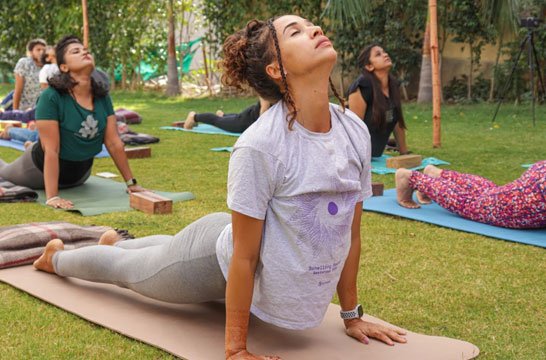According to research and available facts, almost 6-12 percent women are affected by PCOS. It mainly affects women of the child bearing age. It is basically an endocrine gland disorder, that makes the female organs secrete larger quantities of male hormones. Thus, it leads to irregular periods, weight gain, and fertility issues.
However, Yoga can come to your help. You must head to the best yoga school in Rishikesh, to find out more about the treatments and cure through holistic means. However, please keep in mind, that yoga will not be able to cure the root disease, but will help you to manage the symptoms. Before, we delve further and try to unearth the possibilities of treatment, cure, or prevention, you should know a bit about the disease.
Polycystic Ovarian Syndrome Disease
Polycystic Ovarian Syndrome is a disease, that is caused due to the hormonal imbalances in the body. It mainly happens during the reproductive years. All the women, who suffer from this condition show different and varying degrees of symptoms. The excess androgen, the male hormone in the body is the cause of all such symptoms. Cysts also develop in the outer edge of the ovary. The cysts stop the ovary follicles from releasing the eggs. You will learn about human anatomy and physiology in great detail, as a part of the 200 hour yoga teacher training course in Rishikesh.
Some of the other factors, apart from high levels of male hormones in the female body, that contribute to such diseases are insulin resistance, inflammation, and hereditary issues. The first reason why you should get the disease treated, is that, it could lead to infertility, miscarriage, premature birth, and sleep apnea, among many others.
Read More: Why Is Kundalini Yoga Dangerous? The Truth About Its Risks and Rewards
Effect of yoga on Polycystic Ovarian Syndrome
If you are thinking of pursuing yoga in Rishikesh, it is a good decision. Anyone can pursue yoga, no matter what the age. Moreover, you will be able to start training under experts at Hari Om Yoga Vidya School. Here are a few yoga therapies, which can help you to manage the symptoms of Polycystic Ovarian Syndrome better.
⦁ Malasana – It is also called the Garland pose. This asana can strengthen the pelvic floor area, and also the abdominal muscles. Moreover, you will feel your hips opening up. The blood circulation in the pelvic region, also increases manifold. You will also experience better digestion and metabolism, as a result. It is extremely easy to get into the Malasana pose. You have to join your hands, and sit in a deep squat.
The soles of the feet must be flat on the ground and not lifted. Your hands will be within the periphery of the knees. Try to keep the spine as erect as possible. You can hold the pose, according to your convenient time. Moreover, you can repeat the pose thrice. If you do this on a regular basis, you will be able to get things right.
⦁ Setu Bandhasana – It is also called the Bridge pose, as the body resembles a bridge in this pose. This pose can calm your brain, and release excess stress from your body. You have to start by lying down flat on the ground. Slowly, fold the legs and keep them a foot apart. Place both the hands with palms down on either side of the body. While inhaling, slowly lift the pelvis up in the air.
The lower back and mid back also goes up. You ought to roll down your shoulders a bit, and tuck the chin in the chest. Remember to keep the thighs parallel to one another and to the floor as well. Breathe regularly, while you are in this pose. Hold the pose for a certain amount of time, and then release. You can repeat this pose a few times, and you can start noticing the results in a few days.
⦁ Dhanurasana – This is another pose, which will likely benefit women, who have Polycystic Ovarian Syndrome. It also helps in relieving one of menstrual discomfort, by stimulating the reproductive organs. The blood circulation within the pelvic region also increases manifold, as a result of regular practice. Your abdominal organs, neck, shoulders, and legs also get a good stretch as a result of continuous practice of the Dhanurasana.
You have to start, by lying down on the belly. The legs will initially be kept straight, and stretched outwards. Then, slowly you have to hold the feet, with the help of the hands. The chest will also be lifted, floating in the air, and pulled back. At this point, the body resembles a bow, ready to strike. Release yourself from the pose, while leaving the hold on the feet, and slowly come back to the floor. You can repeat this pose a number of times.
Read More: Everything You Need to Know About Kundalini Yoga Teacher Training
These are three of the best asanas for all those women who are suffering from Polycystic Ovarian Syndrome. If you do this asana on a regular basis, you will get relief from the symptoms of the disease. So, head to one of the best yoga schools in Rishikesh today, and join the yoga teacher training course to know more about such therapies.
Deepen Your Yoga Practice with Hari Om Yoga Vidya School
Located in the heart of Rishikesh, Hari Om Yoga Vidya School is a place where ancient yogic wisdom meets modern teaching techniques. As a top yoga school in Rishikesh, we are committed to providing authentic, immersive yoga education in a peaceful, spiritual setting. Recognized as one of the best yoga schools in Rishikesh, we offer structured training programs designed to help you evolve in your practice, whether you are a beginner or an experienced yogi.
If you’re searching for a yoga school in Rishikesh that focuses on holistic learning, experienced teachers, and a supportive community, look no further!
Explore Our Yoga Teacher Training & Retreats
At Hari Om Yoga Vidya School, we offer a range of courses tailored for different levels of practitioners:
✅ 100-Hour Yoga Teacher Training in Rishikesh – A foundational course for those looking to begin their yoga journey.
✅ 200-Hour Yoga Teacher Training in Rishikesh – An internationally recognized certification for aspiring yoga teachers.
✅ 300-Hour Yoga Teacher Training in Rishikesh – Advanced training to deepen your practice and refine your teaching skills.
✅ 7-Day Yoga Retreat in Rishikesh – A rejuvenating escape into yoga, meditation, and self-discovery.
✅ 10-Day Yoga Retreats in Rishikesh – A transformative experience that blends yoga, relaxation, and Himalayan serenity.
Join us for a life-changing experience and become part of our global yoga family! 🌿✨




